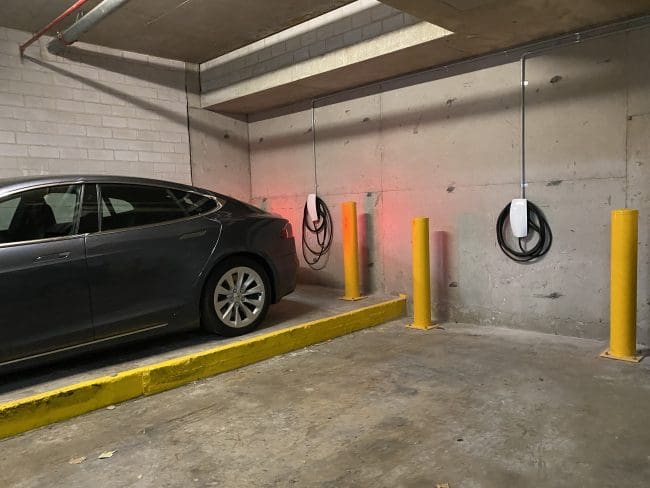Apartment block strata committees are coming up with increasingly bizarre reasons for not installing electric vehicle (EV) charging in their garages, say experts, and it’s starting to affect their ability to rent and sell their properties.
“The excuses they give would be laughable if they weren’t so serious,” said Brent Clark of WattBlock, one of the leading consultants in energy conservation for apartments and increasingly called on to advise on EV charging.
“It all stems from committee members having a vision of every parking space in their block having a fast charger next to it,” he said. “But that almost never happens and really isn’t needed.”
In fact, he said, most buildings would get by with either a few charging bays, possibly using visitor parking spots with service providers handling the billing and payment, or metered normal power to the owners’ car parks.
“The arguments I get include things like the electrical capacity of the block couldn’t cope, because if they allow one person to install charging, then they’d have to allow everyone,” said Mr Clark.
However, not every car owner would be charging an EV at the same time. And the technology exists to limit power usage to off-peak periods when demand is lower, energy is cheaper and the car owners are tucked up in bed. But the reasons for refusing to consider EV charging often have little to do with logic.
“One committee chair said the fuel of the future was hydrogen so there was no point in installing EV chargers,” he said. “An electrical engineer said every spot would need an expensive three-phase connection because battery capacity is getting bigger.
“In fact, the majority of urban trips use less than 25 per cent of capacity so large batteries would only require an overnight top-up before a long journey,” Mr Clark added.
A common objection is that there is no real demand. However a webinar held earlier this year by NSW Department of Energy and Climate was told that apartment dwellers are more likely than house owners to buy electric cars.
They not only tend to be early adopters of new technology but they upgrade their vehicles more frequently. A majority of apartment residents surveyed by the department said their next upgrade would probably be to an electric vehicle.
Dale Cohen, was the secretary of the strata committee at the Richmont building in Sydney’s Pyrmont, when he began lobbying his committee to introduce EV charging back in 2017, two years after he’d bought a plug-in hybrid.
“I started driving purely electric in my local area and I realised this was a big change. But I also realised a lot of people wouldn’t understand it until they did it,” he said.
“The committee’s initial reaction was scepticism. They were willing to listen, but nobody had an electric car. Everybody wrongly assumed it was an all or nothing proposition, that we were going to have to put electric vehicle charging in every spot, and the cost then was in excess of half million dollars for a large building.”
The breakthrough in his block came when a prospective tenant pulled out of a lease because there was no EV charging and no plans to install it. Mr Cohen told his committee that if they didn’t invest in charging facilities, EV owners would buy or rent in buildings that had it. “Our investor owners got that immediately,” he said.
It’s a “chicken and egg thing,” added Mr Cohen, editor and publisher of the Northern Beaches Advocate Newspaper. “Owners’ corporations won’t install EV charging because there are no electric vehicles in the building and no one with an electric car will move into the block because there’s no charging. Meanwhile, existing residents won’t buy one.
In 2020 Mr Cohen and his supporters persuaded the owners corporation to raise $50,000 to install EV charging in, initially, four visitor parking spots. That money was matched by a state government EV fund and City of Sydney also chipped in, while Tesla provided equipment.
“Having EV charging in the block encourages people to think about alternative methods for getting around,” said resident Mark Muntz who shares access to a Tesla with a neighbour. “You only have to put it in for a couple of hours to top up the charge.”
“I use it regularly, partly because of the escalating cost of fuel. Looking long term, I think it’s the only way to go. I literally haven’t used my car for about three months; it’s petrol driven and I feel guilty driving it, to be honest.”
The Richmont, which became the pilot building for NSW government assistance for EV charging infrastructure, now has a charging point in 12 of their visitor parking spots and the garage has been “backboned” so that future EV owners can add easily add charging to their parking spots if they wish.
“The week after we switched on the EV charging, I saw a car I’d never noticed before, charging up in one of our bays,” said Mr Cohen. “That tells you all you need to know.”
This issue is being discussed at length here on the Forum.
An edited version of this article first appeared in the Australian Financial Review.





› Flat Chat Strata Forum › Current Page
Tagged: building permit, charging, electric, EV, EV charging, fire, Insurance, resistance, Strata
Apartment block strata committees are coming up with increasingly bizarre reasons for not installing electric vehicle (EV) charging in their garages,
[See the full post at: Myths and fears behind resistance to EV charging]
The opinions offered in these Forum posts and replies are not intended to be taken as legal advice. Readers with serious issues should consult experienced strata lawyers.
› Flat Chat Strata Forum › Current Page
› Flat Chat Strata Forum › Current Page